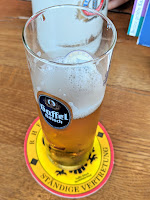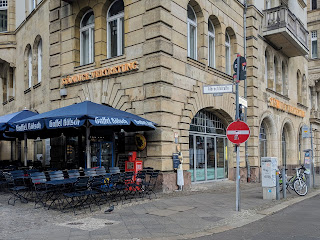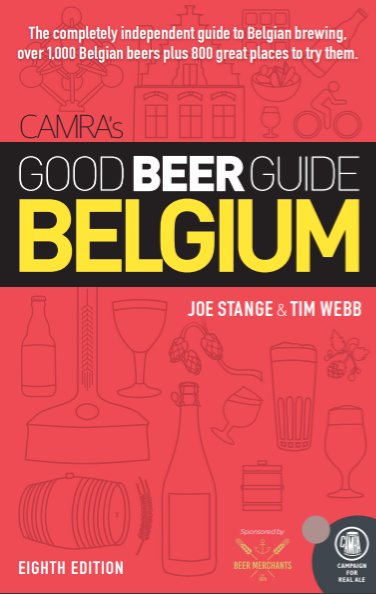Hell, you can even find the Rhineland.
On the north bank of the Spree, but pretending it is the Rhine, is the Ständige Vertretung -- the "Standing Mission." This is near the heart of Mitte, across the river from Friedrichstrasse station, and close to things like the Reichstag and Brandenburg Gate -- perfect spot for a tourist trap. But is it one? That depends on how you define "trap." Does it need to be overpriced and inauthentic to qualify?
There are plenty of places in Berlin where you can wallow in "ostalgia" -- a willfully forgetful longing for East Germany. Here at Ständige Vertretung the thing is "westalgia" -- a wistfulness for the days when the West German capital was in Bonn. The name alludes to the fact that West Germany could not recognize the East as a sovereign nation, so instead of an embassy there was a standing mission. In the Nineties one of the restaurant's founders campaigned loudly against moving the capital from Bonn back to Berlin -- partly, it must be said, to get publicity for his business. The Ständige Vertretung became an outpost of Rhenisch culture, ostensibly for all the uprooted bureaucrats whose work moved to Berlin. Tourists inevitably found it, lured by location, a splash of history, and layers of framed nostalgia.
Fresh Gaffel Kölsch is the beer here. At the bar they'll keep filling 20 cl stange glasses for €1.90 each (about US$2.15). If sitting at a table you can opt for 25 cl (€2.40) or half-liter (€4.80). You can even get a 10-liter pittermännchen -- a spigoted barrel for you and companions to pour yourselves. That costs €89, a slight savings. These prices are somewhat expensive for Berlin; less so if considering the location and specialty.
They churn out plenty of big meaty plates and flammküchen here, but consider the nibbles -- the "Kölsche tapas." You can get bread with lard and crackling (Schmalzstulle) for €2.90, a big meatball/patty (bulette) for €3.20, or (my favorite), the Kölsch Kaviar for €4.50 -- blood sausage on rye rolls with mustard and raw onion. They serve those into the wee hours, after the kitchen has closed.
There also is a Gaffel Haus pub on nearby Dorotheenstraße; it calls itself the Kölsches Konsulat. It's only slightly more expensive; the concept is similar. The scrubtop-table atmosphere is more like the big brewery pubs in Köln, but less cozy than the Standing Mission. (Sadly we don't have a Päffgen outpost here.)
Berlin also has several Bavarian-style beer halls serving Munich Helles, some Franconian-themed places, and even a few Swabian restaurants and pubs. I like the idea of a traveler on a business trip, maybe here for a conference, with no time to go anywhere else in Germany -- but they can still get a taste. Certainly there is such a thing as a useful tourist trap.








